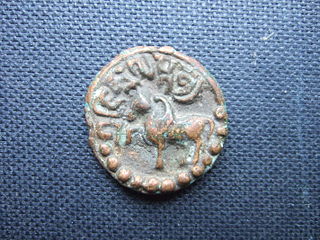
Chandragupta I was a king of the Gupta Empire, who ruled in northern and central India. His title Maharajadhiraja suggests that he was the first emperor of the dynasty. It is not certain how he turned his small ancestral kingdom into an empire, although a widely accepted theory among modern historians is that his marriage to the Licchavi princess Kumaradevi helped him extend his political power. Their son Samudragupta further expanded the Gupta empire.

Licchavi was a kingdom which existed in the Kathmandu Valley in modern-day Nepal from approximately 400 to 750 CE. The Licchavi clan originated from Vaishali, and conquered Kathmandu Valley. The Lichchhavis elected an administrator and representatives to rule them.

The Malla dynasty was the ruling dynasty of the Kathmandu Valley in Nepal from 1201 to 1779. They were a Raghuvanshi dynasty who were seen as the descendants of the Licchavi dynasty. Later Malla kings also traced one section of their lineage from Nanyadeva, the founder of the Karnat dynasty of Mithila. The term malla means wrestler in Sanskrit. The first use of the word malla in the Kathmandu Valley begins from 1201. The Malla period was a golden one that stretched over 600 years, as they presided over and flourished the Newar civilization of Nepal Mandala which developed as one of the most sophisticated urban civilisation in the Himalayan foothills and a key destination in the India-Tibet trade route.
Raya Malla was a Malla Dynasty king and the first King of Bhadgaon after the division of Kathmandu Valley into Kantipur, Patan, and Bhadgaon. He reigned from 1482 until his death in 1505. He was the son of Jayayakshya Malla. His younger brother, Ratna Malla, ruled over Kantipur.
Jayadeva Malla was the son of Abhaya Malla and the third Malla king of Nepal. He started his reign after his father died in the 1255 earthquake until his death in 1258.
King Mānadeva, also Mandev or Mandeva, was a king of Licchavi dynasty in present-day Nepal. He was the son of Dharmadeva, grandson of Shankardeva and the great grandson of Vrsadeva. He suppressed the feudal chiefs of the east and west and also conquered Mallapuri. He minted coins called Mananka and constructed the palace of Managriha for himself which later became a centre of administration of the Licchavi kings.
Amara Malla was a king of the Malla dynasty and the third king of Kantipur. He succeeded his father Surya Malla and ruled from 1530 to 1560.
The earliest inhabitants of modern Nepal and adjoining areas are believed to be people from the Indus Valley civilization. By 4000 BCE, the Tibeto-Burmese people had reached Nepal either directly across the Himalayas from Tibet or via Myanmar and north-east India or both. By the late Vedic period, Nepal was being mentioned in various Hindu texts, such as the late Vedic Atharvaveda Pariśiṣṭa and in the post-Vedic Atharvashirsha Upanishad. The Gopal Bansa was the oldest dynasty to be mentioned in various texts as the earliest rulers of the central Himalayan kingdom known by the name 'Nepal'. The Gopalas were followed by Kiratas who ruled for over 16 centuries by some accounts. According to the Mahabharata, the then Kirata king went to take part in the Battle of Kurukshetra. In the south-eastern region, Janakpurdham was the capital of the prosperous kingdom of Videha or Mithila, that extended down to the Ganges, and home to King Janaka and his daughter, Sita.

The Kingdom of Bhaktapur, also known as Bhadgaon, was a kingdom ruled by the Malla dynasty of Nepal from 15th century until its annexation in the 18th century. It was established in 1482 after King Yaksha Malla died and his sons divided the valley into four kingdoms: Bhaktapur, Kantipur, Patan, and Banepa. Banepa, however, was soon annexed by or submitted itself to Bhaktapur.

The Abhira-Gupta Dynasty was a dynasty which existed in the Kathmandu Valley in modern-day Nepal. These Abhira-Guptas had overshadowed the Licchavi kings in the administration. Ravigupta, Bhaumagupta, Jishnugupta and Vishnugupta of Abhira-Gupta family controlled Kathmandu (Nepal) as de facto-ruler during many Lichchhavi kings.
Shivadeva I was a king of the Licchavi dynasty who ruled Nepal from around 590 to 605 C.E. He was the son of Mana Deva II and lived in a nine-storeyed palace called the Kailashkut Bhavan.
Shivadeva II was the son of Narendradeva and a king of the Licchavi dynasty who ruled Nepal in around 700 C.E.
Bhuwana Malla, also known as Subarna Malla, was a Malla Dynasty king and the second King of Bhadgaon after the division of Kathmandu Valley. He reigned from 1505 until his death in 1519.
Jayabhimadeva was the fourth king of Nepal after Arideva Malla, in which period the Malla dynasty was prominent. He succeeded Jayadeva Malla and reigned from 1258 to 1271.
Jayasimha Malla was the fifth Malla king of Nepal. He succeeded Jayabhimadeva and reigned from 1271 until he was deposed in 1274. His relationship with the dynasty started by Aridev Malla, the first Malla king of Nepal, is still unknown.

Jishnu Gupta, often spelled Jishnugupta, was a de facto ruler of Nepal in the 7th-century during the time of the Lichchhavi dynasty. Initially sharing the administrative powers with Dhruvadeva from 624 CE, he became the highest authority in the realm from around 627. He belonged to the Abhira-Gupta dynasty.
Udaydeva was the son of Shivadeva I and a Lichchhavi king of Nepal. He succeeded Amshuverma in 621 CE but was soon ousted by Jishnu Gupta, and his brother Dhruvadeva. He is also believed to be the father of Bhrikuti.
Dhruvadeva, also spelled Dhruva Deva, was a son of Shivadeva I of the Licchavi dynasty and a king of Nepal in the 7th century. He deposed his brother Udaydeva with the help of Jishnu Gupta and reigned as a figurehead monarch.
Lakshmikamadeva was a Thakuri king of Nepal who reigned from c. 1030–1038.
Bhaskaradeva was a Thakuri king of Nepal who reigned from c. 1039–1047.




